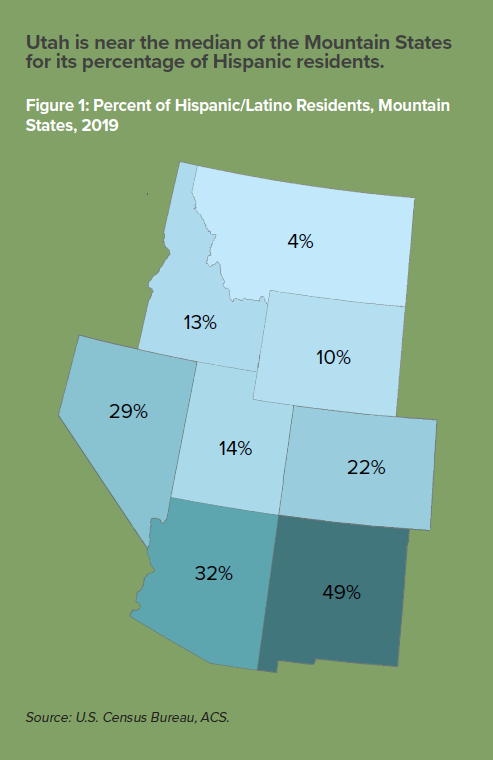Researchers often examine populations by looking closely at certain demographic characteristics to help understand such groups, which can then inform policy decisions. In 2020, a group of Hispanic civic, business and elected leaders approached Utah Foundation asking us to provide key data related to Utah’s Hispanic/Latino population. In addition, this project received support from the Utah Division of Multicultural Affairs.
The metrics in El Estado de los Latinos en Utah: A Look at Utah’s Hispanic/Latino Population are chosen for their connection to the challenges and successes that Hispanic/Latino households might be experiencing, providing a deeper understanding of such households. The metrics may provide insight in crafting policy.

- Hispanic Utahns are younger. The median age for Hispanic Utahns is 25, compared to 31 for all Utahns.
- Some Hispanic Utahns face English language challenges; 3% do not speak English at all and 9% speak it “not well.” More than one-third of Hispanic Utahns were born outside of the U.S., primarily in Mexico.
- Hispanic Utahns tend to have poorer educational outcomes and have far lower educational attainment as compared to Utahns in general. One-third of Hispanic Utahns do not have a high school diploma; only 17% have some kind of post-secondary degree.
- Hispanic Utah households have the highest median income of any Hispanic population in the Mountain States. However, the median income overall in Utah is about 25% higher than that of the Hispanic population.
- Among the Mountain States, Utah has the highest disparity in childhood poverty between Hispanic children and the general population.
- Hispanic Utahns are more likely than Utahns in general to rent their homes. This is true even for moderate- and higher-income Hispanics.
- The fall 2020 data on the coronavirus’ economic impacts show that Hispanic renters are far more likely than Utah renters in general to be behind on their rent payments.
- Hispanic Utahns are far more likely than Utahns in general to have experienced a loss of income since the pandemic. The fall 2020 data on the coronavirus’ economic impacts show that two in five Utahns saw a loss of employment income. For Hispanic Utahns, that impact was three in five.
- A greater proportion of Hispanic Utahns are having a hard time paying usual household expenses during the coronavirus pandemic as compared to Utahns in general.
- Hispanic Utahns are less likely to have health insurance, but are also less likely than Utahns in general to have days with poor physical health.
- Hispanic Utahns are much more likely to report having days with poor mental health compared to Utahns in general.
While this report focuses on Hispanic Utahns, it is important to note that it explores a set of challenges that are neither universal to all Hispanic Utahns nor set in stone. Rather, many of these challenges are what one might expect within a group containing a high proportion of immigrants with low educational attainment levels. As educational attainment increases, many of those challenges will subside. Utah is already seeing a rapid increase in graduation rates among Hispanic students. And Hispanic Utahns are currently outperforming their counterparts in the other Mountain States and at the national level in terms of income levels.

